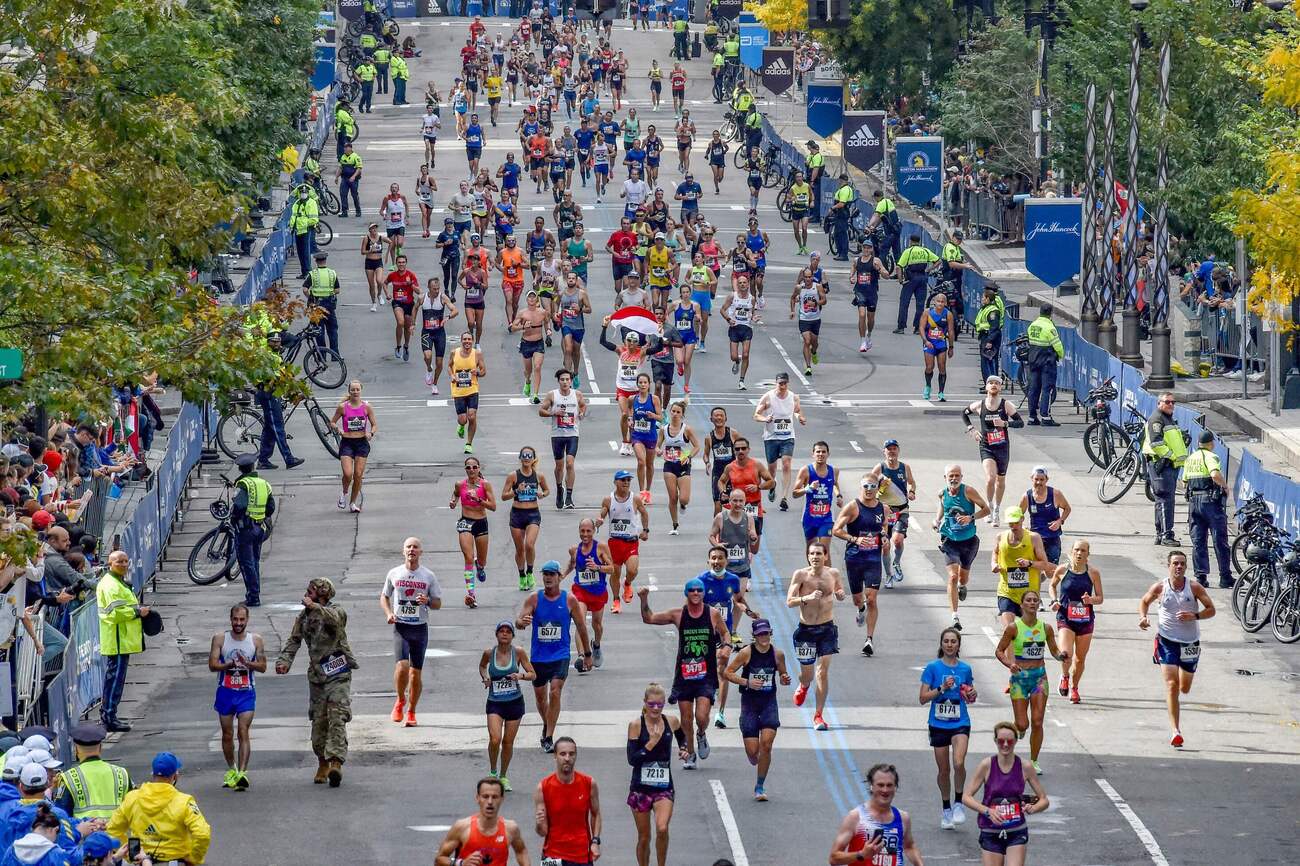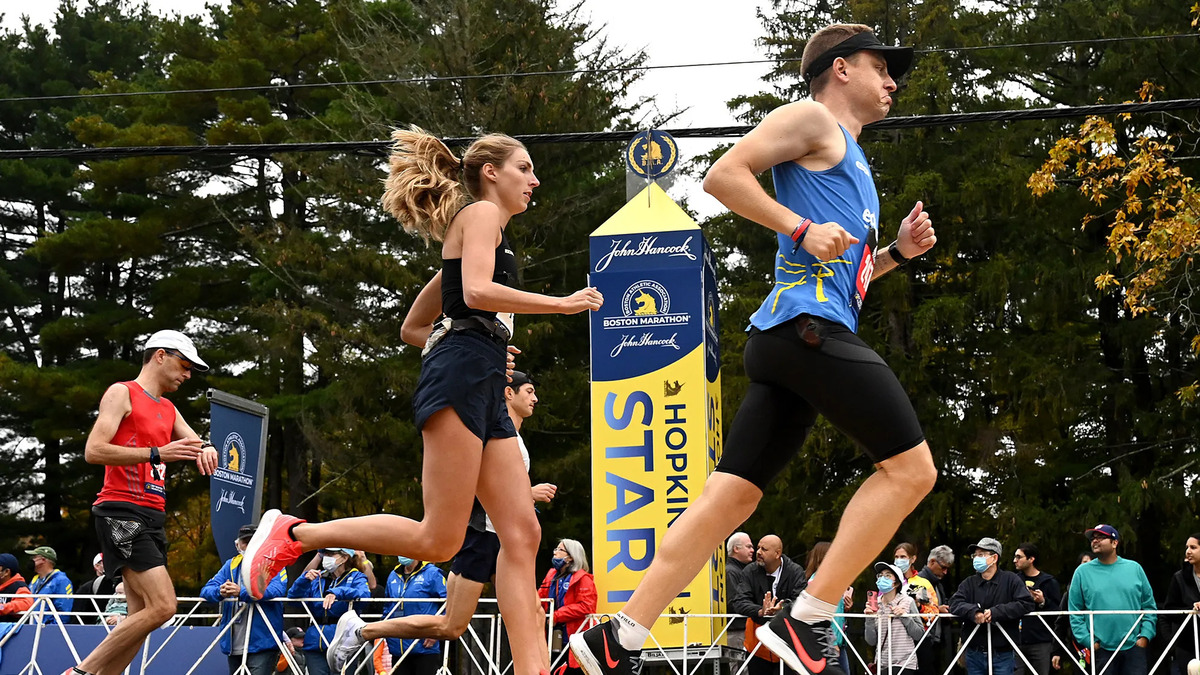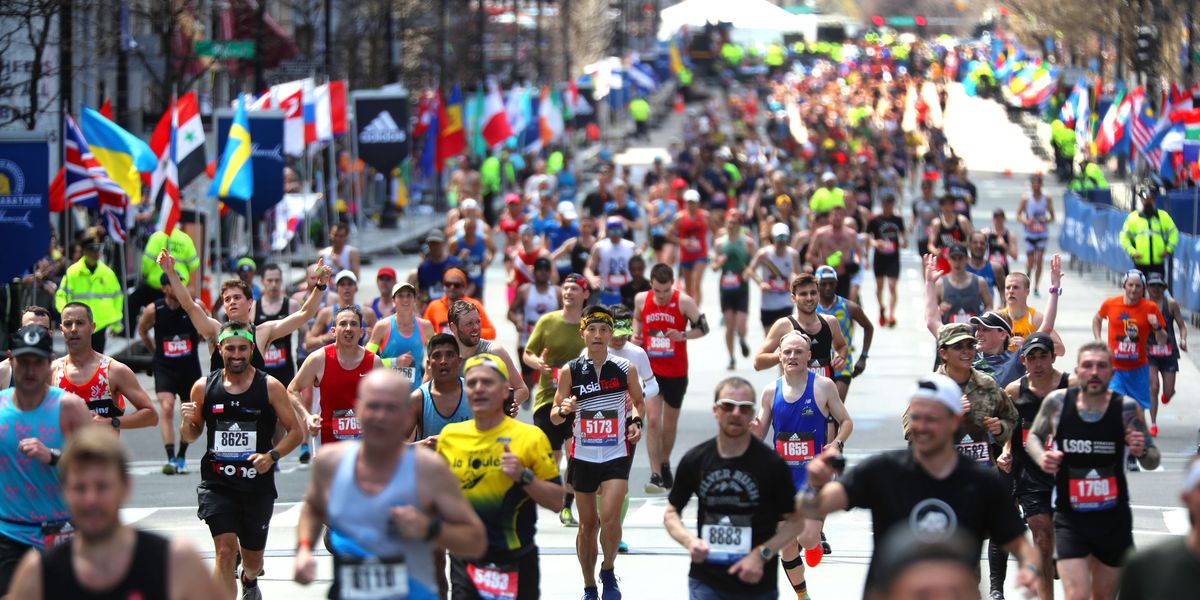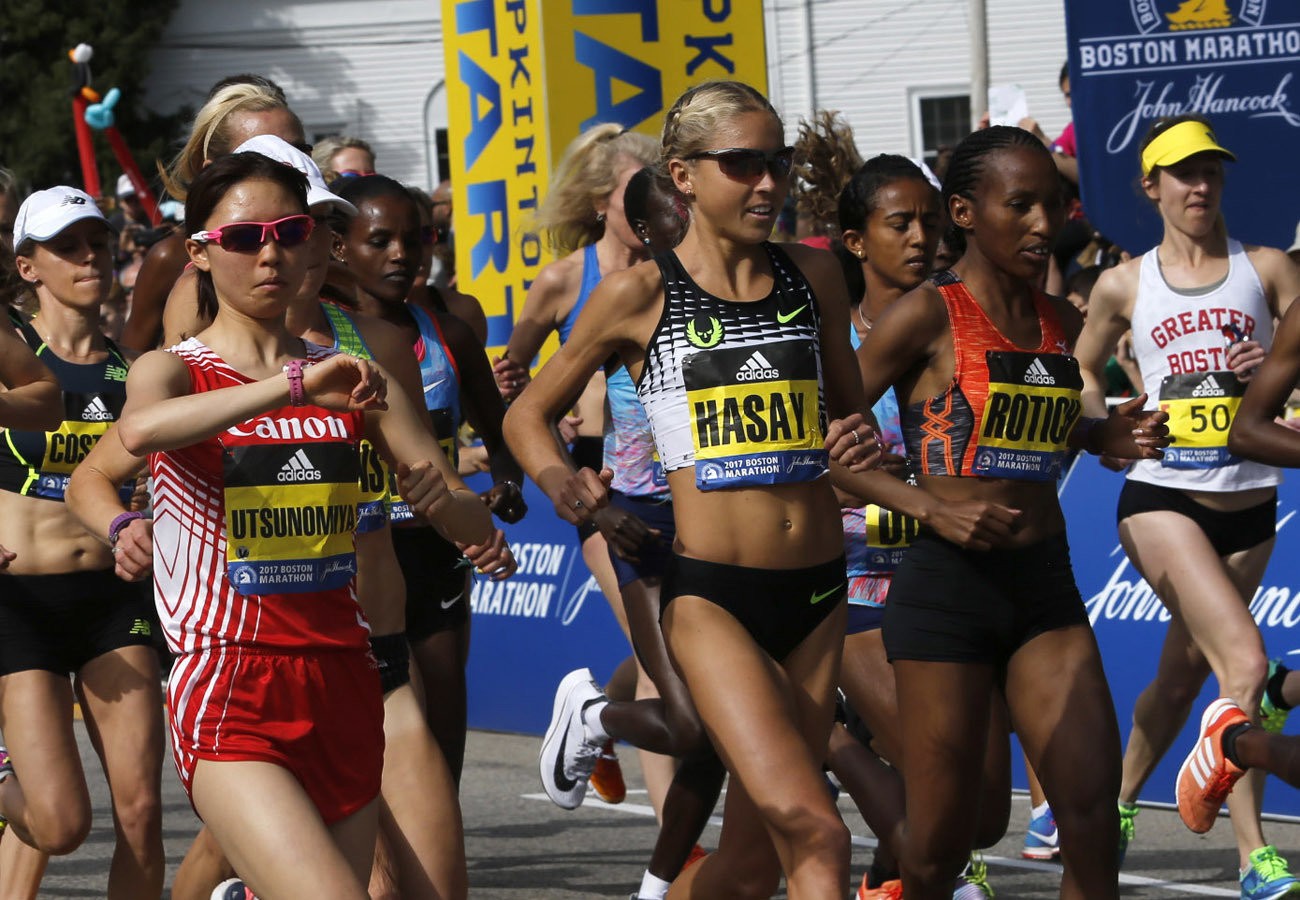

Featured
How To Train For Boston Marathon
Modified: August 21, 2023
Learn the best training techniques and strategies to prepare for the prestigious Boston Marathon. Featured tips for runners aiming to conquer this iconic race.
Introduction
Training for the Boston Marathon is an incredibly rewarding and challenging endeavor. As one of the most prestigious and iconic races in the world, it requires dedication, commitment, and proper preparation. Whether you are a seasoned runner or a beginner looking to take on this extraordinary feat, this article will provide you with valuable insights and tips to help you train effectively for the Boston Marathon.
The Boston Marathon is known for its demanding course and the stringent qualifying standards. It attracts elite athletes as well as passionate amateur runners from around the globe. To successfully complete this race, you need to have a comprehensive training plan that focuses on building endurance, increasing speed, preventing injuries, and maintaining mental resilience.
In this article, we will guide you through the process of choosing the right training plan, setting realistic goals, establishing a training schedule, and incorporating various training techniques to optimize your performance. We will also discuss the importance of nutrition and hydration, as well as injury prevention and recovery strategies.
Training for the Boston Marathon is not just about physical fitness and athletic ability; it requires mental fortitude as well. We will explore strategies for mental preparation and developing the right mindset to overcome challenges and push through the tough moments during the race.
Whether you are aiming for a personal best time, a Boston qualifying time, or simply looking to complete the race, this article will provide you with valuable information to help you train effectively and make your Boston Marathon experience a memorable one. So, lace up your running shoes and let’s dive into the world of training for the Boston Marathon!
Choosing the Right Training Plan
When embarking on your journey to the Boston Marathon, selecting the right training plan is crucial to your success. There are various training programs available, each catering to different skill levels and goals. Here are some key factors to consider when choosing the right training plan:
- Assess Your Fitness Level: Take an honest assessment of your current fitness level. Evaluate your running experience, average weekly mileage, and recent race performances. This will help you determine if you should opt for a beginner, intermediate, or advanced training plan.
- Consider Your Goals: Identify your specific goals for the Boston Marathon. Are you aiming to complete the race, achieve a personal best time, or qualify for future Boston Marathons? Different training plans emphasize different aspects of training, such as building endurance or increasing speed. Choose a plan that aligns with your goals.
- Time Commitment: Evaluate your schedule and determine how much time you can dedicate to training. Some training plans require a higher time commitment with multiple workouts per day, while others offer a more flexible approach. Select a plan that fits well with your lifestyle and work commitments.
- Training Methodology: Consider the training methodologies used in the plan. Some plans focus on a high volume of mileage, while others incorporate more interval and speed training. Think about your preferences and what type of training you enjoy the most.
- Flexibility: Look for a training plan that offers some degree of flexibility. This is particularly important for busy individuals or those who may require adjustments due to unexpected events or commitments. Flexibility allows you to make modifications without compromising the overall structure of the plan.
Once you have considered these factors, it’s time to research and explore different training plans. Look for reputable sources, such as running magazines, books, or trusted online platforms that provide well-structured and proven training programs.
Remember that no training plan is a one-size-fits-all solution. You may need to make modifications or adapt it to suit your individual needs. Listen to your body and make adjustments as needed, taking into account your recovery and injury prevention strategies.
Choosing the right training plan sets the foundation for a successful Boston Marathon journey. It provides structure, guidance, and ensures you are adequately prepared for the physical and mental demands of the race. So, take your time, do your research, and select a plan that aligns with your goals and suits your individual needs.
Setting Realistic Goals
Setting realistic goals is an essential part of training for the Boston Marathon. Whether you are aiming to qualify for the race, achieve a personal best time, or simply looking to successfully complete the distance, having clear and attainable goals will guide your training and keep you motivated throughout the process. Here are some tips for setting realistic goals:
- Assess Your Current Fitness Level: Evaluate where you are currently in terms of your running fitness. Consider your recent race performances, training consistency, and average weekly mileage. This will give you a baseline to determine what is feasible for you to achieve.
- Consider Your Past Performance: Take a look at your previous marathon or long-distance race times to get an idea of your capabilities. It’s important to be objective and not to set unrealistic expectations based on one exceptional race. Consider your overall consistency and performance trends.
- Research Boston Marathon Qualifying Times: If qualifying for the Boston Marathon is your goal, familiarize yourself with the qualifying time standards for your age and gender. Be realistic about your current fitness level and whether you can realistically achieve those times within the given training timeline.
- Break Down Your Goals: Instead of focusing solely on the end result, break down your goals into smaller, achievable milestones. Set incremental time goals for specific distances, such as reaching certain paces for shorter races or hitting target splits in your training runs. By celebrating these smaller victories, you will stay motivated and build confidence.
- Consider External Factors: Factors such as weather conditions, course difficulty, and race day circumstances can impact your performance. Take these factors into account when setting your goals and be prepared to adjust your expectations accordingly.
- Listen to Your Body: Be mindful of any existing injuries or limitations. Setting goals that are too ambitious can increase the risk of injury. It’s important to strike a balance between pushing yourself and prioritizing your long-term health and well-being.
Setting realistic goals will help you maintain focus and stay motivated throughout your training journey. Remember, it’s better to set goals that challenge you but are achievable rather than setting unrealistic expectations that may lead to disappointment.
Keep in mind that goals can evolve as your training progresses. Be flexible and willing to adjust your goals if necessary. The journey to the Boston Marathon is a personal one, and your goals should reflect your individual aspirations and capabilities. Embrace the process, stay committed, and celebrate every milestone along the way.
Establishing a Training Schedule
Establishing a well-structured training schedule is crucial when preparing for the Boston Marathon. A well-planned schedule helps you stay consistent, track your progress, and ensure you are adequately prepared for the race day. Here are some key considerations when establishing your training schedule:
- Plan Your Training Duration: Determine the length of your training plan leading up to the race. The recommended duration is usually around 12-16 weeks, but it can vary depending on your current fitness level and experience. It’s essential to have a long enough timeframe to gradually build your fitness without risking overtraining or injury.
- Establish Milestone Races: Incorporate milestone races into your training schedule. These can include shorter races or tune-up races at various distances leading up to the marathon. These races will help gauge your progress, provide valuable race experience, and fine-tune your pacing strategies.
- Consider Your Weekly Mileage: Assess your current weekly mileage and gradually increase it over time. The ideal weekly mileage will depend on your experience and goals. Be cautious not to increase your mileage too quickly, as this can increase the risk of injury. A general rule of thumb is to increase mileage by no more than 10% per week.
- Include Rest and Recovery Days: Rest days are just as important as training days. Schedule regular rest and recovery days throughout your training schedule to allow your body to adapt and repair. These days are crucial for preventing injuries and ensuring optimal performance during key training sessions.
- Allocate Time for Cross-Training: Incorporate cross-training activities such as swimming, cycling, or strength training into your schedule. Cross-training helps improve overall fitness, prevent overuse injuries, and provides variety to your training routine.
- Prioritize Long Runs: Long runs are a vital component of marathon training. Gradually increase the distance of your long runs, peaking a few weeks before the marathon. These runs simulate race conditions, build endurance, and help you mentally prepare for the race distance.
- Consider Your Lifestyle: Take into account your work, family, and other commitments when establishing your training schedule. Be realistic about the time you can allocate to training and find a balance that works for you. Remember, consistency is key, so choose a schedule that you can realistically stick to.
Once you have established your training schedule, it’s important to monitor your progress and make adjustments as necessary. Listen to your body and be flexible in adapting your schedule to accommodate unforeseen circumstances or physical limitations.
Remember, your training schedule is a guide, not a strict rule. Be open to modifications and adjustments based on how your body responds to the training load. Give yourself the best chance for success by establishing a well-planned and balanced training schedule that allows you to progress gradually and build your fitness leading up to the Boston Marathon.
Building Endurance
Building endurance is a fundamental aspect of training for the Boston Marathon. Endurance allows you to sustain the effort and maintain a steady pace over the 26.2-mile distance. Here are some strategies to help you build endurance effectively:
- Gradual Progression: One of the key principles of building endurance is gradual progression. Start with a comfortable training distance and gradually increase your mileage each week. This gradual increase allows your body to adapt to the increased workload and reduces the risk of injury.
- Long Runs: Incorporate long runs into your training program. Start with a distance that challenges you, but is achievable, and gradually increase the length of your long runs over time. Aim to cover at least 20-22 miles in your longest training run to build confidence and simulate the demands of the marathon distance.
- Tempo Runs: Tempo runs are an excellent way to build endurance and improve your lactate threshold. These runs involve running at a comfortably hard pace for an extended period. Incorporate regular tempo runs into your training schedule to improve your ability to sustain a faster pace for a longer time.
- Hill Training: Include hill workouts in your training routine. Running uphill challenges your cardiovascular system, strengthens your leg muscles, and improves your overall endurance. Incorporate hill repeats or hill sprints into your workouts to simulate the hilly sections of the Boston Marathon.
- Cross-Training: Engage in cross-training activities such as swimming, cycling, or elliptical training to improve your cardiovascular fitness without putting excessive stress on your joints. Cross-training provides variety, allows for active recovery, and contributes to overall endurance building.
- Mental Strategies: Building endurance is not just physical; it’s also mental. Train your mind to stay focused and overcome mental fatigue. Practice positive self-talk, visualization, and develop strategies to stay mentally tough during the long training runs, which will translate to race day success.
- Hydration and Fueling: Proper hydration and fueling strategies are essential for building endurance. Experiment with different hydration methods during your long runs to find what works best for you. Practice fueling during training to ensure your body can efficiently utilize energy sources during the marathon.
Consistency is key when building endurance. Stick to your training schedule, increase your mileage gradually, and remain committed to your long runs and challenging workouts. Be patient and trust the process. Building endurance takes time and cannot be achieved overnight.
Remember to listen to your body and make adjustments as needed. If you experience persistent fatigue or feel excessively sore, it may be a sign to dial back the intensity or volume of your training. Proper rest and recovery are essential components of endurance building.
By following these strategies and staying dedicated to your training plan, you will gradually build the endurance necessary to tackle the Boston Marathon with confidence and determination.
Speed and Interval Training
Speed and interval training are essential components of your Boston Marathon training plan. These workouts help improve your running economy, increase your lactate threshold, and enhance your overall speed. Incorporating speed and interval training into your routine will help you achieve your desired race pace and make you a more efficient and faster runner. Here are some key strategies for effective speed and interval training:
- Warm-Up: Prior to any speed or interval workout, it’s crucial to warm up properly. Perform dynamic stretches, jog for a few minutes, and include some strides to gradually increase your heart rate and prepare your body for the intensity of the workout.
- Track Workouts: Utilize a track or a measured course to perform your interval workouts. This allows for accurate timing and distance measurement. Examples of track workouts include 400-meter repeats, 800-meter repeats, or ladder workouts with varying distances.
- Vary Your Intervals: Incorporate a range of interval distances and paces into your training. This will improve your ability to run at different speeds and adapt to varying race conditions. Include shorter, faster intervals for speed development and longer intervals to improve endurance and stamina.
- Timing and Recovery: Pay attention to your interval timing and recovery periods. The duration and intensity of your intervals depend on your training goals. Shorter intervals with shorter recovery periods focus on speed, while longer intervals with longer recoveries target endurance. Adjust your interval lengths and recovery times based on your fitness level and the specific demands of the Boston Marathon.
- Progressive Workouts: Incorporate progressive workouts into your training program. Start with a moderate pace and gradually increase your speed throughout the interval session. This progressive approach helps simulate the increasing effort required during the later stages of a marathon.
- Hill Repeats: Include hill repeats in your training to improve both strength and speed. Find a challenging hill and power up it at a hard effort. Jog or walk downhill for recovery before repeating the ascent. Hill repeats not only build leg strength but also enhance mental toughness.
- Mind Your Form: Pay attention to your running form during speed and interval workouts. Maintain good posture, engage your core, and focus on a quick turnover and efficient stride. Proper form allows for optimal energy transfer and reduces the risk of injury.
- Recovery Days: After intense speed and interval sessions, prioritize recovery. Give your body time to rest and repair to avoid overtraining and mitigate the risk of injury. Use recovery days for easy runs, cross-training, or complete rest.
Integrate speed and interval training into your routine gradually, especially if you are new to high-intensity workouts. Start with shorter intervals and longer recovery periods, gradually increasing the distance and reducing the recovery time over time.
Remember, consistency is key. Incorporate speed and interval training into your routine once or twice a week, depending on your training plan and running background. Be patient, stay committed, and trust the process. With consistent speed and interval workouts, you will improve your speed, increase your lactate threshold, and ultimately become a stronger and faster runner.
Strengthening the Core
Strengthening your core is a vital component of Boston Marathon training. A strong core improves stability, enhances running mechanics, and reduces the risk of injuries. Incorporating core exercises into your routine will not only improve your running performance but also contribute to better posture, balance, and overall body strength. Here are some key strategies for strengthening your core:
- Planks: Planks are a foundational exercise for core strength. Start with the basic forearm plank, ensuring your body forms a straight line from your head to your heels. Gradually increase the duration or progress to more challenging variations such as side planks or plank twists.
- Crunches and Sit-ups: These exercises target your abdominal muscles. Perform controlled crunches or full sit-ups, engaging your core and avoiding strain on your neck and back. You can vary the intensity by adding twists or incorporating stability balls.
- Russian Twists: Russian twists target your oblique muscles. Sit with your feet off the ground and lean back slightly. Rotate your torso from side to side, while maintaining a straight back and engaged core. You can hold a medicine ball or weight plate for added resistance.
- Leg Lifts: Leg lifts focus on lower abdominal strength. Lie flat on your back and lift your legs off the ground. Slowly lower them back down without touching the floor. For an added challenge, perform flutter kicks or scissor kicks.
- Bridge Pose: Bridge pose strengthens your glutes, lower back, and core. Lie on your back with your knees bent, feet flat on the ground. Raise your hips off the floor, creating a straight line from your knees to your shoulders. Hold the position for a few seconds before lowering back down.
- Pilates and Yoga: Incorporate Pilates or yoga exercises that target the core muscles. These workouts focus on stability, flexibility, and strength. Look for classes or videos that specifically emphasize core work.
- Balance Exercises: Balancing exercises such as single-leg stands or the use of stability balls help improve core stability and proprioception. Stand on one leg, engaging your core to maintain balance, or perform exercises on a stability ball to challenge your core muscles further.
- Functional Movements: Include functional movements that engage your core, such as squats, lunges, and deadlifts. These compound exercises not only target multiple muscle groups but also require core stabilization and strengthen your overall body.
Incorporate core exercises into your training routine at least two to three times a week. Aim for a variety of exercises that target different areas of your core and progressively increase the intensity or difficulty as your strength improves.
Remember to listen to your body and maintain proper form during core exercises. It’s essential to engage your core muscles and avoid relying solely on momentum. If you’re unsure about proper technique, consider working with a certified personal trainer or physical therapist to ensure you perform the exercises correctly.
Strengthening your core is a valuable investment in your overall fitness and running performance. By incorporating regular core exercises into your training routine, you will build a solid foundation of strength, stability, and resilience to support you during the demands of the Boston Marathon.
Cross-Training
Cross-training is an essential component of Boston Marathon training. Incorporating other forms of exercise into your routine alongside running offers numerous benefits, including injury prevention, improved overall fitness, and enhanced performance. It provides variety, helps prevent overuse injuries, and allows you to maintain your cardiovascular fitness without putting excessive stress on your joints. Here are some key strategies for effective cross-training:
- Select Complementary Activities: Choose activities that complement running and target different muscle groups. Good options include swimming, cycling, elliptical training, rowing, or using the stair climber. These low-impact exercises provide cardiovascular benefits and engage different muscle groups.
- Maintain Cardiovascular Fitness: Cross-training allows you to maintain your cardiovascular fitness while reducing the risk of overuse injuries. By engaging in alternative activities, you continue to improve your endurance and aerobic capacity without the repetitive impact of running.
- Focus on Strength Training: Incorporate strength training exercises into your cross-training routine. Strengthening your muscles not only improves overall fitness but also helps prevent muscle imbalances and provides greater stability during running. Focus on exercises that target the major muscle groups, including legs, glutes, core, and upper body.
- Flexibility and Mobility Work: Use cross-training sessions to work on your flexibility and mobility. Engage in activities such as yoga, Pilates, or dedicated stretching routines. These exercises help improve joint range of motion, prevent muscle tightness, and enhance running efficiency.
- Active Recovery: Cross-training can be an ideal way to engage in active recovery. After a challenging run or intense workout, choose a low-impact activity to promote blood flow, aid in muscle recovery, and reduce soreness. This can include easy swimming, light cycling, or gentle walking.
- Mental Refreshment: Cross-training provides a mental break from running while still maintaining your fitness. Trying new activities can be refreshing and rejuvenating, keeping your motivation high and preventing burnout. It allows you to approach your running sessions with renewed energy and enthusiasm.
- Timing and Integration: Schedule cross-training sessions strategically within your training plan. Consider placing them on your easy or recovery days to actively recover while maintaining your fitness level. Alternatively, use cross-training as a substitute for a scheduled run if you’re feeling fatigued or need extra recovery.
- Listen to Your Body: Pay attention to your body’s signals during cross-training activities. Monitor your exertion level, ensure proper form, and avoid overexertion. If an activity causes pain or discomfort, modify or avoid it, and consult with a healthcare professional if necessary.
Remember that cross-training should complement your running, not replace it. Running-specific conditioning is important to prepare your body for the demands of the Boston Marathon. Thus, prioritize your running workouts while incorporating cross-training as a supplementary component of your training plan.
Find activities that you enjoy and that align with your individual preferences and goals. Mix up your cross-training activities to keep yourself engaged and motivated. Be consistent, but also be flexible and willing to adjust your cross-training routine as needed.
By including cross-training in your training plan, you’ll reap the benefits of improved overall fitness, reduced risk of injury, and enhanced performance on race day. Embrace the variety and embrace the opportunity to strengthen your body while maintaining a well-rounded approach to your Boston Marathon preparation.
Nutrition and Hydration
Proper nutrition and hydration are integral parts of your Boston Marathon training. Fueling your body with the right nutrients and maintaining optimal hydration levels are essential for sustained energy, enhanced performance, and efficient recovery. Here are some key strategies for nutrition and hydration during marathon training:
- Balance Your Macronutrients: Focus on a well-balanced diet that includes carbohydrates, proteins, and healthy fats. Carbohydrates provide the primary fuel for endurance activities, while proteins support muscle repair and growth. Healthy fats contribute to overall health and provide sustained energy.
- Hydrate Adequately: Maintain proper hydration throughout your training by drinking fluids regularly. Start your runs well hydrated, and drink water or electrolyte drinks during and after your workouts to replenish lost fluids. Monitor the color of your urine; if it’s pale yellow, you’re likely drinking enough.
- Pre-Workout Meals: Consume a balanced meal containing carbohydrates, proteins, and healthy fats 2-3 hours before your training sessions. This allows sufficient time for digestion and energy absorption. Choose easily digestible foods to avoid discomfort during your workouts.
- During-Run Fueling: Practice fueling strategies during long runs and tune-up races to find what works best for you. Consume easily digestible carbohydrates (such as gels, chews, or sports drinks) every 30-45 minutes to maintain energy levels during prolonged exercise.
- Post-Run Recovery: Refuel after your training sessions with a combination of carbohydrates and protein within 30-60 minutes. Consuming this recovery meal or snack helps replenish glycogen stores, repairs muscle damage, and promotes optimal recovery.
- Variety and Whole Foods: Focus on whole, nutrient-dense foods to meet your nutritional needs. Include a variety of fruits, vegetables, whole grains, lean proteins, and healthy fats in your diet to ensure you obtain a wide range of essential nutrients.
- Experiment before Race Day: Test your nutrition and hydration strategies during your long runs and tune-up races. This allows you to practice the timing, types of fuel, and hydrating methods that work best for your body, minimizing the risk of digestive issues on race day.
- Recovery Hydration and Nutrition: Proper recovery extends beyond hydration. Consume a balanced meal or snack within 1-2 hours after your runs to replenish your energy stores. Include a mix of carbohydrates and proteins to support muscle repair and recovery.
- Consult a Registered Dietitian: If you have specific dietary concerns or questions regarding your nutrition and hydration needs, consider consulting a registered dietitian. They can provide personalized advice based on your individual requirements and help optimize your marathon training nutrition.
Remember that nutrition and hydration strategies are individualized, and what works for one runner may not work for another. It’s essential to experiment and find what works best for you through trial and error during your training.
Lastly, always prioritize wholesome, nutrient-dense foods to support your overall health and well-being. Nourishing your body properly will optimize your training efforts, boost your performance, and set you up for success on marathon day.
Injury Prevention
Injury prevention is a critical aspect of Boston Marathon training. The high volume of running and the demands of intense workouts increase the risk of overuse injuries. Implementing injury prevention strategies will help keep you healthy, improve your performance, and ensure you reach the starting line in optimal condition. Here are some key strategies for injury prevention:
- Gradual Progression: Gradually increase your mileage, intensity, and the duration of your workouts over time. Avoid sudden spikes in training volume, as this can overload your body and increase the risk of injuries. Aim for a weekly mileage increase of no more than 10%.
- Proper Warm-Up and Cool-Down: Prioritize a dynamic warm-up before each run to activate your muscles and prepare them for the workout. Cool down with static stretching and gentle movements to promote flexibility and reduce muscle soreness.
- Strength and Conditioning: Incorporate strength and conditioning exercises into your routine. Focus on exercises that target the muscles used in running, including the hips, glutes, core, and lower limbs. Strong muscles provide better support and stability, reducing the risk of overuse injuries.
- Listen to Your Body: Pay attention to warning signs of potential injuries, such as persistent pain, discomfort, or abnormal sensations. If you experience pain that doesn’t improve with rest, consult a healthcare professional for evaluation and appropriate treatment.
- Rest and Recovery: Allow for adequate rest and recovery days in your training schedule. Rest days are just as important as training days and give your body time to repair and adapt to the training stress. Prioritize quality sleep, nutrition, and active recovery methods to promote optimal recovery.
- Proper Running Form: Work on maintaining proper running form to minimize unnecessary stress on your body. Focus on maintaining an upright posture, a slight forward lean from the ankles, and a midfoot strike. Avoid overstriding and excessive vertical bouncing.
- Footwear and Equipment: Choose appropriate running shoes that provide proper support, cushioning, and fit your foot mechanics. Replace your shoes regularly to ensure optimal shock absorption. Additionally, wear moisture-wicking clothing and comfortable gear to prevent chafing and irritation.
- Cross-Training and Variety: Incorporate cross-training activities into your routine to reduce the impact and stress on your body. Activities such as swimming, cycling, or elliptical training provide cardiovascular benefits while giving your running muscles a break.
- Stretching and Flexibility: Maintain flexibility through regular stretching and flexibility exercises. Focus on areas prone to tightness, such as calves, hamstrings, hip flexors, and the IT band. Improved flexibility can reduce muscle imbalances and help prevent injuries.
- Professional Guidance: If you have a history of injuries or any concerns about your training, consider consulting with a healthcare professional or a running specialist. They can assess your movement patterns, provide personalized advice, and help address any underlying issues or imbalances.
Remember, injury prevention is ongoing throughout your training. Implementing these strategies consistently will not only reduce the risk of injuries but also contribute to your overall performance, allowing you to reach your full potential on marathon day.
Recovery and Rest Days
Recovery and rest days are crucial components of your Boston Marathon training plan. They play an essential role in allowing your body to repair, adapt, and come back stronger after intense workouts. Prioritizing recovery and incorporating regular rest days into your training schedule will help optimize your performance, reduce the risk of overuse injuries, and ensure long-term success. Here are some key strategies for recovery and rest days:
- Active Recovery: Engage in light, low-impact activities on your rest days to promote blood flow and aid in muscle recovery. Activities such as gentle swimming, walking, or cycling can help alleviate muscle soreness and fatigue.
- Ice Baths and Cold Therapy: Consider using ice baths or cold therapy techniques to reduce inflammation and promote muscle recovery. Submerging your legs in cold water or using ice packs after intense workouts can help minimize muscle soreness and accelerate recovery.
- Compression and Massage: Utilize compression garments or tools such as foam rollers or massage balls to help alleviate muscle tension and promote circulation. These techniques can aid in recovery, reduce muscle soreness, and improve flexibility.
- Nutrition and Hydration: Refuel your body with a combination of carbohydrates and proteins after your workouts to replenish glycogen stores and support muscle repair. Adequate hydration is also essential for optimal recovery, so ensure you drink enough fluids throughout the day.
- Quality Sleep: Prioritize quality sleep to allow your body to recover and regenerate. Aim for 7-9 hours of uninterrupted sleep each night. Establish a consistent sleep routine and create a restful environment to optimize your recovery process.
- Reduce Stress: Manage your stress levels both during training and in your daily life. High levels of stress can impair recovery and increase the risk of injury. Incorporate stress-reducing activities such as yoga, meditation, or deep breathing exercises into your routine.
- Modify Intensity or Volume: If you’re feeling excessively fatigued or notice persistent muscle soreness or pain, consider modifying the intensity or volume of your workouts. Adjust your training schedule to allow for additional recovery time, and don’t be afraid to take an extra rest day if necessary.
- Listen to Your Body: Pay attention to your body’s signals and be mindful of any signs of overtraining or excessive fatigue. If you experience persistent pain or discomfort that doesn’t improve with rest, consult with a healthcare professional for further evaluation and appropriate treatment.
- Positive Mindset: Use rest days as an opportunity to cultivate a positive mindset and mental resilience. Embrace the downtime, reflect on your progress, and visualize successful race performances. Mental rejuvenation is just as important as physical recovery.
- Adjustments as Needed: Be flexible with your training schedule and make adjustments as needed. Every runner’s recovery needs are different, so listen to your body and make modifications accordingly. Remember, rest and recovery are essential for long-term training success.
Remember that recovery is an ongoing process and should be integrated into your training plan consistently. By prioritizing recovery and incorporating rest days, you allow your body to adapt and maximize the benefits of your hard work. Embrace the rest days as an integral part of your training journey to ensure you reach peak performance on race day.
Mental Preparation
While physical training is crucial for the Boston Marathon, mental preparation is equally important. The marathon is a grueling distance that pushes your physical and mental limits. Cultivating a strong and resilient mindset will help you overcome challenges, stay focused, and maintain motivation throughout your training and on race day. Here are some key strategies for mental preparation:
- Set Clear and Realistic Goals: Define your goals for the marathon and set realistic expectations. Establishing clear objectives will give you a sense of purpose and direction during training. Break down larger goals into smaller milestones to track your progress and celebrate achievements along the way.
- Visualization: Use visualization techniques to mentally rehearse your race. Imagine yourself running strong, feeling confident, and crossing the finish line. Visualizing success helps build confidence and strengthens your belief in your abilities.
- Positive Self-Talk: Practice positive self-talk to challenge negative thoughts and replace them with constructive and encouraging messages. Use affirmations and mantras that resonate with you, such as “I am strong,” “I am capable,” or “I can do this.” Cultivating a positive inner dialogue boosts confidence and resilience.
- Mindfulness and Stress Management: Incorporate mindfulness practices, such as meditation or deep breathing exercises, into your routine. These techniques help calm the mind, reduce anxiety, and improve focus. Additionally, find healthy ways to manage stress outside of training to prevent it from negatively impacting your performance.
- Break the Race into Segments: Instead of focusing solely on the entire marathon distance, mentally break the race into smaller, more manageable segments. Have a strategy for each segment, such as maintaining a steady pace for the first half, pushing through the middle miles, and finishing strong in the final stretch. This approach helps prevent feeling overwhelmed and allows you to stay present and focused.
- Practice Mental Toughness: Prepare yourself mentally for the expected discomfort and challenges that may arise during the marathon. Embrace discomfort as part of the process and develop strategies to push through difficult moments. Remember that running a marathon requires mental resilience and determination.
- Stay Present and Maintain Focus: Concentrate on the present moment during training runs and races. Maintain focus on your form, breathing, and the task at hand. Avoid dwelling on past performances or worrying about future outcomes. Staying present helps you perform at your best and prevents mental fatigue.
- Learn from Setbacks: View setbacks and obstacles as opportunities for growth. There may be setbacks during your training, such as missed workouts or less-than-ideal race performances. Instead of dwelling on them, learn from the experience, adapt your strategy, and use them as motivation to become even better.
- Seek Support: Surround yourself with a supportive network of family, friends, and fellow runners. Share your goals and challenges with them. Their encouragement and understanding will help you stay motivated and provide a sense of accountability.
- Celebrate Small Victories: Celebrate your progress and small victories along the way. Recognize and acknowledge your dedication, improvements, and milestones. Celebrating achievements boosts confidence and keeps you motivated throughout your training journey.
Remember that mental preparation is an ongoing process. Consistently work on developing a positive mindset, staying focused, and managing stress throughout your training. Be patient with yourself, embrace the journey, and trust in your ability to conquer the Boston Marathon both physically and mentally.
Final Thoughts
Training for the Boston Marathon is a challenging and rewarding endeavor that requires dedication, perseverance, and a well-rounded approach. As you embark on this journey, keep in mind the following final thoughts:
First and foremost, trust in the process. Marathon training takes time, consistency, and patience. Be committed to your training plan, but also listen to your body and make adjustments as needed. Your training may have ups and downs, but staying resilient and maintaining a positive mindset will carry you through.
Remember that your journey is unique to you. While it can be helpful to seek advice and guidance from experienced runners or coaches, ultimately, you know your body the best. Adapt training plans and strategies to suit your individual needs and goals. What works for others may not necessarily work for you.
Stay mindful of the importance of rest and recovery. Refuel your body with nutritious foods, stay hydrated, and prioritize quality sleep. Implement activities that promote relaxation and stress management, such as meditation or hobbies you enjoy. Taking care of your body and mind is key to achieving your best performance on race day.
Embrace the ups and downs of training. There may be days when your motivation wanes, and running feels difficult. During those moments, remind yourself of your goals and the reasons why you started this journey. Drawing on your inner determination and resilience will help you push through any challenges you encounter.
Lastly, enjoy the process. Training for the Boston Marathon is a unique and transformative experience. Embrace the joy in every run, the camaraderie of fellow runners, and the satisfaction of seeing yourself grow stronger and more capable with each passing day. Cherish the small victories and celebrate your progress along the way.
As you prepare for the Boston Marathon, know that you’re embarking on an incredible adventure that will challenge and inspire you. Trust in your training, believe in yourself, and savor every moment of this remarkable journey. You have what it takes to conquer the Boston Marathon, so lace up your shoes, hit the road, and embrace the incredible experience that awaits you at the finish line.









